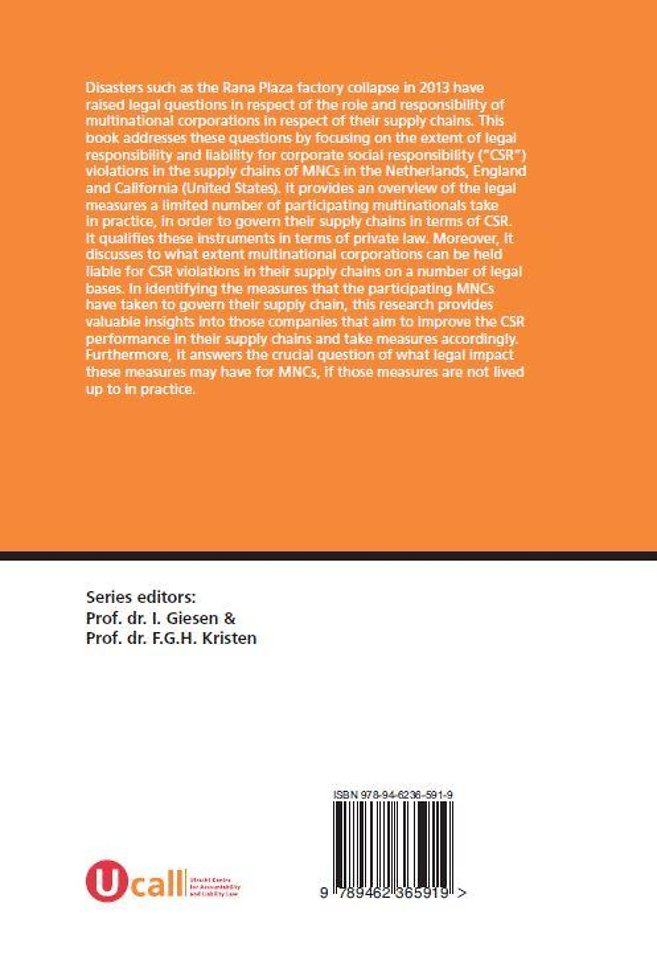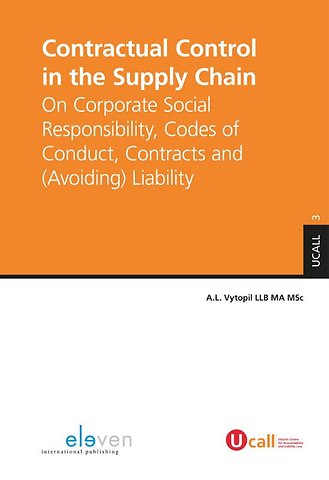Contractual control in the supply chain
On corporate social responsibility, codes of conduct, contracts and (avoiding) liability
Samenvatting
Disasters such as the Rana Plaza factory collapse in 2013 have raised legal questions in respect of the role and responsibility of multinational corporations in respect of their supply chains. This book addresses these questions by focusing on the extent of legal responsibility and liability for corporate social responsibility (“CSR”) violations in the supply chains of MNCs in the Netherlands, England and California (United States). It provides an overview of the legal measures a limited number of participating multinationals take in practice, in order to govern their supply chains in terms of CSR. It qualifies these instruments in terms of private law.
Moreover, it discusses to what extent multinational corporations can be held liable for CSR violations in their supply chains on a number of legal bases. In identifying the measures that the participating MNCs have taken to govern their supply chain, this research provides valuable insights into those companies that aim to improve the CSR performance in their supply chains and take measures accordingly. Furthermore, it answers the crucial question of what legal impact these measures may have for MNCs, if those measures are not lived up to in practice.
Target group: Practitioners and academics in the field of corporate law, contract law and corporate governance.
Specificaties
Inhoudsopgave
Definitions and abbreviations
Chapter 1
Introduction
1.1 Rana Plaza
1.2 Research
1.3 Structure of this book
1.4 Reading guide
Chapter 2
Research design and methodology
2.1 Introduction
2.2 Aim
2.3 Research questions
2.4 Research method
2.4.1 Jurisdictions: reasons and delimitation
2.4.2 Research design
2.4.3 Which companies were approached?
2.4.3.1 The Netherlands
2.4.3.2 England
2.4.3.3 California, United States
2.5 Model
2.6 Limitations and delimitations of the research
2.6.1 Limitations
2.6.2 Delimitations
2.7 Relevance of the research
Chapter 3
CSR and the supply chain: setting the stage and identifying issues
3.1 Introduction
3.2 Setting the stage
3.2.1 Introduction
3.2.2 The rise of corporate social responsibility
3.2.3 Why CSR?
3.2.4 CSR: the current ((semi-)legal) status
3.2.5 Conclusion
3.3 The supply chain
3.3.1 Introduction
3.3.2 Supply chain strategy theory
3.3.3 Case study supply chain: Nike
3.3.4 Supply chain contracting and CSR
3.3.5 CSR in the supply chain
3.4 Conclusion
Chapter 4
Private international law
4.1 Introduction
4.2 The Netherlands and England
4.2.1 Jurisdiction
4.2.2 Applicable Law
4.2.2.1 Contracts
4.2.2.2 Pre-contractual phase
4.2.2.3 Torts
4.3 California
4.3.1 Jurisdiction
4.3.1.1 Jurisdiction in contract cases
4.3.1.2 Jurisdiction in tort cases
4.3.1.3 Alien Tort Statute
4.3.1.4 Other procedural aspects: class actions
4.3.2 Applicable law
4.3.2.1 Contracts
4.3.2.1 Pre-contractual phase
4.3.2.2 Torts
4.4 Final notes
Chapter 5
Legal qualification of contracts, general terms and conditions and
codes of conduct
5.1 Introduction
5.1.1 Contracts
5.1.1.1 Sources of contract law and contract formation
5.1.1.2 Content of the contract: requirements and interpretation
5.1.1.3 Rights and obligations for third parties
5.1.2 General terms and conditions
5.1.3 Pre-contractual questionnaires
5.1.4 Codes of conduct
5.1.4.1 Bindingness for the multinational
5.1.4.2 Bindingness in the supply chain
5.2 The Netherlands
5.2.1 Sources and principles of contract law
5.2.2 Contract formation
5.2.3 Content of a contract: requirements and interpretation
5.2.4 Pre-contractual questionnaires and content of the contract
5.2.5 General terms and conditions
5.2.5.1 When do general terms and conditions apply?
5.2.5.2 Regulation of content of general terms and conditions
5.2.5.3 Battle of the forms
5.2.6 Rights and obligations of third parties
5.2.6.1 Rights
5.2.6.2 Obligations
5.2.7 Codes of conduct
5.2.7.1 Bindingness of codes of conduct for the MNC in general
5.2.7.2 Bindingness of codes of conduct in supply chains
5.3 England
5.3.1 Sources and principles of contract law
5.3.2 Requirements for contract formation
5.3.3 Content of a contract: requirements and interpretation
5.3.4 Pre-contractual questionnaires
5.3.5 General terms and conditions
5.3.5.1 When do general terms and conditions apply?
5.3.5.2 Regulation of content of general terms and conditions
5.3.5.3 Battle of the forms
5.3.6 Contracts and the rights and obligations of third parties
5.3.6.1 Rights
5.3.6.2 Obligations
5.3.7 Codes of conduct
5.3.7.1 Bindingness of codes of conduct for the MNC in general
5.3.7.2 Bindingness of codes of conduct in supply chains
5.4 California, United States
5.4.1 Sources and principles of contract law
5.4.2 Contract formation
5.4.3 Content of a contract: requirements and interpretation
5.4.4 Pre-contractual questionnaires
5.4.5 General terms and conditions
5.4.5.1 When do general terms and conditions apply?
5.4.5.2 Regulation of content of general terms and conditions
5.4.5.3 Battle of the forms
5.4.6 Contracts and the rights and obligations of third parties
5.4.6.1 Rights
5.4.6.2 Obligations
5.4.7 Codes of conduct
5.4.7.1 Bindingness of codes of conduct for the MNC in general
5.4.7.2 Bindingness of codes of conduct in supply chains
5.4.7.3 Regulation of the content of codes of conduct
5.5 Conclusions
Chapter 6
Instruments in practice
6.1 Introduction
6.2 Content of CSR instruments: model
6.3 Results
6.3.1 The Netherlands
6.3.1.1 Content
6.3.1.2 Form of initiatives: COCs, general terms and conditions or contracts?
6.3.1.3 Patterns
6.3.1.4 Private international law, battle of the forms
6.3.1.5 Other aspects: third parties, implementation, self-assessment
questionnaires
6.3.2 England
6.3.2.1 Content
6.3.2.2 Form of initiatives: COCs, general terms and conditions or contracts?
6.3.2.3 Patterns
6.3.2.4 Private international law, battle of the forms
6.3.2.5 Other aspects: third parties, implementation
6.3.3 California
6.3.3.1 Content
6.3.3.2 Form of initiatives: COCs, general terms and conditions or contracts?
6.3.3.3 Patterns
6.3.3.4 Private international law, battle of the forms
6.3.3.5 Other aspects, implementation
6.4 Conclusion
Chapter 7
Liability of the multinational in the supply chain and CSR instruments
7.1 Introduction
7.2 The Netherlands
7.2.1 Introduction
7.2.2 Breach of contract in respect of a third party beficiary
7.2.3 Liability on the basis of a tort (onrechtmatige daad)
7.2.3.1 Elements of an action on the basis of section 6:162 DCC
7.2.3.2 Liability for omissions
7.2.3.3 Liability for the act of a third party
7.2.3.4 Liability for CSR violations
7.2.3.5 Conclusion
7.2.4 Misleading advertising
7.2.4.1 Introduction
7.2.4.2 Liability for unfair commercial practices towards consumers
7.2.4.2.1 Overview of the requirements under the UCP Directive and
sections 6:193a DCC and further
7.2.4.2.2 Legal requirements
7.2.4.2.3 Enforcement
7.2.4.3 Liability for misleading publicity towards other businesses
7.2.4.4 Tony’s Chocolonely Chocolate
7.2.4.5 Conclusions on misleading publicity
7.2.5 Conclusion
7.3 England
7.3.1 Introduction
7.3.2 Breach of contract in respect of a third party beneficiary
7.3.3 Liability on the basis of the tort of negligence
7.3.3.1 Elements of an action for negligence
7.3.3.2 Duty of care
7.3.3.2.1 Affirmative duty of care
7.3.3.2.2 Duty of care in respect of CSR violations
7.3.3.2.3 Duty of care of the MNC for human rights violation in the supply chain
7.3.3.3 Breach of duty
7.3.3.4 Causation
7.3.3.5 Conclusion
7.3.4 Misleading advertising
7.3.4.1 Consumer protection against unfair commercial practices
7.3.4.2 Business Protection from Misleading Marketing
7.3.4.3 Enforcement of the CPR and BPR
7.3.4.4 Non-legal measures: the Advertising Standards Authority and
CSR claims
7.3.4.5 Conclusions on misleading advertising
7.3.5 Conclusion
7.4 California
7.4.1 Introduction
7.4.1.1 Alternative options
7.4.2 Breach of contract in respect of a third party
7.4.2.1 Illustration: Doe v. Wal-Mart Stores, Inc.: a claim by a third party
beneficiary to a code of conduct for breach of contract
7.4.2.2 Claimant as third party beneficiary to an enforceable contract
7.4.2.3 Breach of contract
7.4.2.4 Conclusion
7.4.3 Liability on the basis of the tort of negligence
7.4.3.1 Negligence in Californian law: concept and requirements
7.4.3.2 Duty of care
7.4.3.2.1 Negligent undertaking
7.4.3.2.2 Negligent retention of control
7.4.3.2.3 Negligent performance of contract in respect of a third party
beneficiary
7.4.3.2.4 Common law negligence and negligence per se
7.4.3.3 Breach of duty, proximate and legal cause, damages
7.4.3.3.1 Breach of a duty of care
7.4.3.3.2 Causation
7.4.3.4 Conclusions
7.4.4 Liability for false advertising
7.4.5 Conclusions
7.5 International initiatives
7.5.1 Bangladesh Accord on Fire and Building Safety
7.5.2 Alliance for Bangladesh Worker Safety
7.5.3 Conclusions
7.6 Final notes
Chapter 8
CSR instruments studied and liability
8.1 Introduction
8.2 The Netherlands
8.2.1 Findings on instruments in practice
8.2.2 Breach of contract in respect of a third party beneficiary and
instruments in practice
8.2.2.1 Formal binding nature of instruments
8.2.2.2 Bindingness of content
8.2.2.3 Obligation for the MNC?
8.2.2.4 Third party beneficiary
8.2.2.5 Conclusion on breach of contract in respect of a third party beneficiary
8.2.3 Liability on the basis of a tort (onrechtmatige daad)
8.2.4 Misleading advertising
8.2.5 Conclusions
8.3 England
8.3.1 Findings on instruments in practice
8.3.2 Breach of contract in respect of a third party beneficiary and
instruments in practice
8.3.2.1 Formal binding nature of instruments
8.3.2.2 Bindingness of content
8.3.2.3 Obligation for the MNC?
8.3.2.4 Benefit for third party
8.3.2.5 Conclusion on breach of contract in respect of a third party beneficiary
8.3.3 Liability on the basis of the tort of negligence
8.3.4 Misleading advertising
8.3.5 Conclusions
8.4 California
8.4.1 Findings on instruments in practice
8.4.2 Breach of contract in respect of a third party beneficiary and
instruments in practice
8.4.2.1 Formal binding nature of instruments
8.4.2.2 Bindingness of content
8.4.2.3 Obligation for the MNC?
8.4.2.4 Third party
8.4.2.5 Conclusion on breach of contract in respect of a third party beneficiary
8.4.3 Liability on the basis of a tort
8.4.4 Misleading advertising
8.4.5 Conclusions
8.5 Final notes
Chapter 9
Conclusion: possibilities and limitations of (private) law
Epilogue
Final notes
Summary
Samenvatting
Bibliography
Case law
Annex I: model letter, invitation to participate and list of questions for interviews
Index
Curriculum vitae
Anderen die dit boek kochten, kochten ook
Net verschenen
Rubrieken
- aanbestedingsrecht
- aansprakelijkheids- en verzekeringsrecht
- accountancy
- algemeen juridisch
- arbeidsrecht
- bank- en effectenrecht
- bestuursrecht
- bouwrecht
- burgerlijk recht en procesrecht
- europees-internationaal recht
- fiscaal recht
- gezondheidsrecht
- insolventierecht
- intellectuele eigendom en ict-recht
- management
- mens en maatschappij
- milieu- en omgevingsrecht
- notarieel recht
- ondernemingsrecht
- pensioenrecht
- personen- en familierecht
- sociale zekerheidsrecht
- staatsrecht
- strafrecht en criminologie
- vastgoed- en huurrecht
- vreemdelingenrecht







